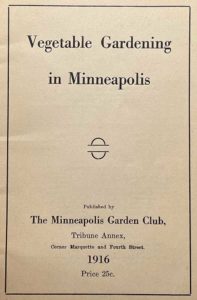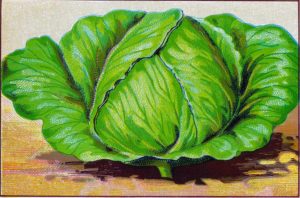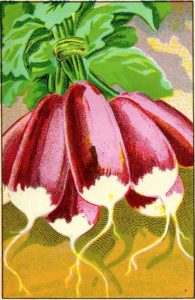Small Home Gazette, Spring 2021
The Minneapolis Garden Club
 In 1916, the average date of the last killing frost in the spring in Minneapolis was April 27, according to the Vegetable Gardening in Minneapolis booklet published by The Minneapolis Garden Club. (You can download the booklet from the Twin Cities Bungalow Club website.) Today, University of Minnesota professor emeritus Mark Seeley says in the last 20 years, April 20 was the average date for the last frost. Global warming is a serious change for Twin Cities gardeners since the bungalow era.
In 1916, the average date of the last killing frost in the spring in Minneapolis was April 27, according to the Vegetable Gardening in Minneapolis booklet published by The Minneapolis Garden Club. (You can download the booklet from the Twin Cities Bungalow Club website.) Today, University of Minnesota professor emeritus Mark Seeley says in the last 20 years, April 20 was the average date for the last frost. Global warming is a serious change for Twin Cities gardeners since the bungalow era.
 Yet, some aspects of gardening seem perennial, like efforts to convert vacant city lots into gardens. In 1912, The Minneapolis Garden Club had plans to attempt to convert every empty city lot into a garden. Nearly 120 years later, improvement associations still work to convert vacant city lots into gardens. Today, Minneapolis has a garden lease program, where city-owned vacant lots are available to qualifying community or market gardens to lease to grow food. The Star Tribune hosts an annual “Beautiful Gardens” contest. In 2019, the newspaper had more than 380 nominations. Winners still receive recognition in the newspaper. Gone are the cash prizes and silver cup trophies awarded by The Minneapolis Tribune, a forerunner of the current Star Tribune.
Yet, some aspects of gardening seem perennial, like efforts to convert vacant city lots into gardens. In 1912, The Minneapolis Garden Club had plans to attempt to convert every empty city lot into a garden. Nearly 120 years later, improvement associations still work to convert vacant city lots into gardens. Today, Minneapolis has a garden lease program, where city-owned vacant lots are available to qualifying community or market gardens to lease to grow food. The Star Tribune hosts an annual “Beautiful Gardens” contest. In 2019, the newspaper had more than 380 nominations. Winners still receive recognition in the newspaper. Gone are the cash prizes and silver cup trophies awarded by The Minneapolis Tribune, a forerunner of the current Star Tribune.
The Minneapolis Garden Club
 The Minneapolis Garden Club, started in 1910, was a civic organization whose object was “to beautify the city, making it a more pleasing place to live—and a more desirable place to visit.” The club claimed “a considerable degree of responsibility for Minneapolis being one of the most beautiful cities in the United States.” It was supported by The Minneapolis Tribune and the Minneapolis Real Estate Board. In 1912, 58 Minneapolis improvement associations were “working to make Minneapolis beautiful.”
The Minneapolis Garden Club, started in 1910, was a civic organization whose object was “to beautify the city, making it a more pleasing place to live—and a more desirable place to visit.” The club claimed “a considerable degree of responsibility for Minneapolis being one of the most beautiful cities in the United States.” It was supported by The Minneapolis Tribune and the Minneapolis Real Estate Board. In 1912, 58 Minneapolis improvement associations were “working to make Minneapolis beautiful.”
Men led the club. The officers were “public spirited men” who devoted their time to the work without pay. Men from Minneapolis were sent to every section of the county to organize and superintend clubs of similar nature.
Initially, the club focused almost exclusively on vegetable production in tandem with “the World War” (WWI), then expanded to landscape work. In 1921, club membership was $1 a year, and it offered members landscape services designed especially for moderately priced homes, those costing $6,500 and less.
 A May 1922 article in The Minneapolis Tribune quoted James T. Elwell, president of the City Planning commission and head of the Minneapolis Garden Club. “It seems that the home owners of Minneapolis have been educated in the beautification of their home and to some extent are turning from extensive vegetable gardening, which they took up during the war, to beautifying of their homes.” Trees, shrubs and flowers were said to add $200 to $800 to the market value of the average home. Whenever shrubbery abounds in yards of homes offered for sale, the real estate agent invariably mentions it in his advertisement.
A May 1922 article in The Minneapolis Tribune quoted James T. Elwell, president of the City Planning commission and head of the Minneapolis Garden Club. “It seems that the home owners of Minneapolis have been educated in the beautification of their home and to some extent are turning from extensive vegetable gardening, which they took up during the war, to beautifying of their homes.” Trees, shrubs and flowers were said to add $200 to $800 to the market value of the average home. Whenever shrubbery abounds in yards of homes offered for sale, the real estate agent invariably mentions it in his advertisement.
 If you were to pick up the club’s 1916 vegetable booklet, the guidance is solid for growing beans, beets, cabbages, carrots, cauliflower, celery, cucumbers, eggplants, kohlrabi, lettuce, muskmelons, onions, parsley, parsnips, peas, potatoes, radish, spinach, squash, sweet corn, tomatoes, and turnips. Please do not try to follow the advice on spraying for pests! If you are even able to find the recommended arsenate of lead or paris green, you would find them harmful to far more than insects.
If you were to pick up the club’s 1916 vegetable booklet, the guidance is solid for growing beans, beets, cabbages, carrots, cauliflower, celery, cucumbers, eggplants, kohlrabi, lettuce, muskmelons, onions, parsley, parsnips, peas, potatoes, radish, spinach, squash, sweet corn, tomatoes, and turnips. Please do not try to follow the advice on spraying for pests! If you are even able to find the recommended arsenate of lead or paris green, you would find them harmful to far more than insects.
The club bragged about distributing to members 2,000 rhubarb roots; 5,000 seedling pines; 6,000 ornamental shrubs; 6,000 currant bushes; and 10,000 fruit trees among other plants and seed packages. I have to wonder if the rhubarb plants that a friend divided and passed on to me might have had their roots in The Minneapolis Garden Club.











